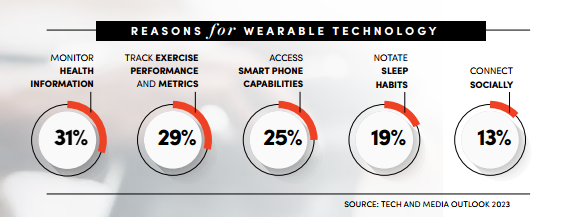Wearable technology is expected to become a $400+ billion market.
Wearable technology has emerged as a leading trend in the fitness realm for 2024, according to the American College of Sports Medicine’s “Future Directions of the Health and Fitness Industry” survey. Fitness trackers, smartwatches and heart rate monitors are transforming the wellness landscape, and with the wellness category constituting more than one third of the direct selling industry, these trends could help strengthen consumer attention in that space.
Market research by Modor Intelligence forecasts the wearable technology market to grow from $186.5 billion in 2023 to a staggering $419.4 billion by 2028. The evolution of wearable tech, driven by MEMS (micro-electromechanical system) sensors, has paved the way for dedicated devices monitoring health and activities. From smartwatches to VR/AR headsets, wearables are integrating into daily life. Studies show a surge in wearable adoption—particularly for fitness and health management—with the global pandemic accelerating remote health management and solidifying telehealth’s role.
Smartwatches, like Apple’s Series 8, are gaining traction, appealing even to older demographics because of their health-monitoring features. Amazon’s entry into wearables raises the competitive bar, with gesture-controlled earphones signaling increased rivalry. While technological advancements continue, challenges in data security and complexity persist. Despite setbacks during the COVID-19 pandemic, the wearables market is poised for growth, driven by innovation and a surge in health-conscious consumers.
Wearable payments are made easy with built-in near-field communication (NFC) technology in devices like smartwatches and fitness trackers, allowing users to make transactions conveniently on the go. For health and fitness tracking, nearly one in three Americans uses wearable devices. More than 80 percent of users are willing to share data from these devices with their doctors. Notably, earrings are now emerging as health trackers, monitoring vital statistics such as heart rate, body temperature and blood oxygen levels.

Looking into the future of wearables, innovations include a shirt equipped with GPS through haptic feedback and shoes that convert movement into energy to power internal sensors and other devices.
FIVE Rapidly Emerging Wearable Tech Trends
Ignitec, a design and technology consultancy agency, revealed its top-five trending wearables to keep an eye on. Here are the top three insights for each.
1/ Embedded Technology
- Exciting possibilities with sensors and processors embedded into clothing or accessories.
- Eliminates bulky external components, ensuring comfort and easy integration into daily life.
- Software trends include container adoption; programming language debates; security focus; agile methodologies; and multicore microcontrollers.
2/ Augmented & Virtual Reality
- AR and VR technologies in wearables are untapped but rapidly growing.
- IDC forecasts a 32.3 percent compound annual growth rate, reaching $50.9 billion by 2026.
- Trends involve growth in the Metaverse, closer integration of AR and AI; improved AR navigation for GPS systems; and lightweight headsets.
3/ Smart Fabrics & Textiles
- Integration of electronics into fabric for sensing or communication purposes.
- Opens possibilities for interactive garments and smart shoes.
- E-textiles compete with dominant wearables (smartwatches, fitness trackers) for discreet health monitoring.
4/ AI Integration
- Focus on advanced AI capabilities in wearables.
- Big players like Google and Apple lead in voice-activated interactions.
- Expect more AI-powered features, such as personalized “smart” workouts.
5/ Hearables
- Combine hearing aid and headphone functionalities.
- Bluetooth streaming with health tracking and hearing aid features.
- Trends include biometric sensors; contextual location-based suggestions; environment-based noise suppression; and gesture/touch-based control.
From the March 2024 issue of Direct Selling News magazine.


